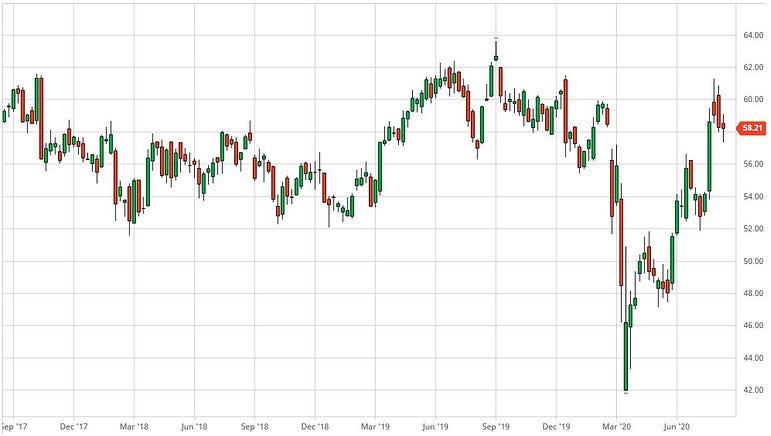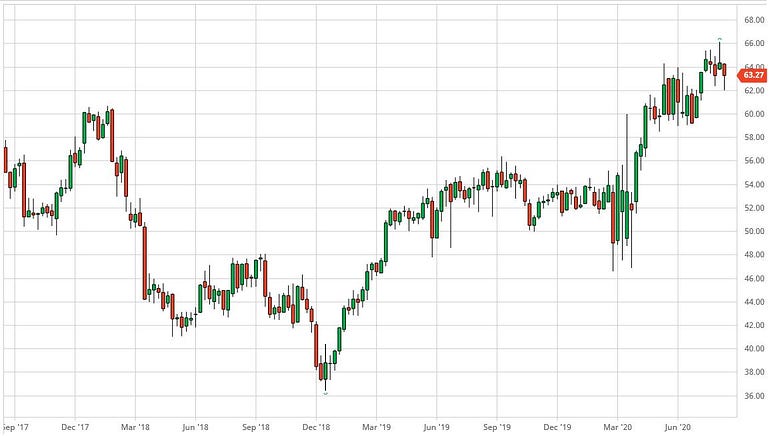Do you want stocks that pay out reliable bonuses? Then you should take a look at these two depots. Some stocks have been paying dividends for at least 100 years.
A little brain teaser to get you started: Put yourself back in the days when there was still interest. When it was completely normal to get three, four or more percent returns per year on solid government bonds.
Wasn’t it common at the time to hold these papers for five years or maybe even longer and enjoy the regular returns? The fact that the bonds fluctuated strongly in the meantime when the yield level on the market changed, bothered very few. As a rule, they were kept 100 percent at the due date until they were repaid.
Investors should also approach investments in high-dividend stocks in the same way. Think of them as interest-bearing paper and do not let yourself be disturbed by intermittent price dips. Even with solid stocks, in the vast majority of cases, any price setbacks are completely ironed out after three to five years, and there are often even decent price gains.
Return with Allianz or Procter & Gamble
“I just want my money to bring a return” — this is what papers like the consumer goods giant Procter & Gamble from the USA or the insurer Allianz from Germany fully meet.
I present you two specific portfolios, each with five manageable values, which bring a dividend yield of up to 4.4 percent. A portfolio is based on international stocks in order to spread the (economic) risks geographically and yields an average of 3.7 percent.
The other Portfolio focuses on stocks from the USA, the most powerful economy in the world, all of which have been paying dividends continuously for more than 100 years, in one case for 204 years (average return: 3.1 percent).
The main focus when choosing the stocks was on decent and above all steady dividends — but not on the currently highest payments. Because data clearly shows that especially those stocks beat the market that pay consistently above-average dividends — and not those that have the absolute highest dividend yields.
Steady cash-flow
The distribution of the funds across several stocks stabilizes the flow of dividends. Should a comany pay less, there is a good chance that another deposit will pay out more. Due to the different dividend dates and, above all, because most US companies, but also some companies from other countries, pay quarterly, you don’t just receive a distribution once a year as with interest-bearing securities.
This is good for liquidity, but also offer mental advantages: If you regularly see dividend credits on the deposit account statement, you can immediately feel that your money is working for you. In this way, investors survive intermittent price losses more easily and avoid panic selling at unfavorable prices.
No “new interest” — but that doesn’t matter
Again and again one can read that dividends are the new interest. Investors should be aware that this is not the case. With interest investments, regardless of whether bank accounts or bonds, the annual income flows regardless of the success of the provider (although here too there can be defaults due to the issuer risk).
Dividends, on the other hand, are the participation of the shareholders in the business of the company. As the corona crisis shows, these premiums can temporarily fall or even be canceled even with solid companies. But even then — and now comes the second part of our mind game — investors only end up where they would be with interest rate investments: namely with a return of zero.
While the interest rate will probably be extremely low or even negative for many years to come, perhaps even for the rest of your investor life, most stock companies return to distributions shortly after a crisis. To put it into perspective: During the high phase of the financial crisis between 2008 and 2010, which had a much more serious economic impact than the corona pandemic (at least so far), only 38 of the 160 companies from the german stock indices canceled their dividends.
And these were mainly smaller companies. This was not the case for any of the values presented. Another positive aspect is that, unlike interest rates, there will hardly be any negative dividends in the future either!
Dividend portfolio: international and very traditional
Here you will find two portfolios with particularly lucrative dividend stocks, with which investors distribute earnings opportunities and risk across several countries — or bet on stocks from the USA that have been paying out for more than 100 years.
The US utility York Water has been paying dividends to its shareholders since 1816 — since the first year of its existence. And above all: without any interruption, despite two world wars, the Great Depression in the 1930s or the financial crisis from 2008.
Sure, the Pennsylvanian company’s business or providing water to local citizens has been exceptionally stable, enabling regular remittances. But by no means only York Water has been pouring out consistently for well over a century.
The generous traditionalists include the conglomerate Johnson Controls (since 1887) and the consumer goods giant Procter & Gamble (since 1890). These values can be found in the “Portfolio for 100+ years olds”.
It consists exclusively of stocks from the USA, as most stock corporations with such a long dividend history are listed there due to the capital market.
Investors who choose this portfolio option are betting on the world’s strongest economy with the dollar as its key currency. However, you should note that if the greenback is temporarily weak, the returns for investors who calculate in euros may also be temporarily lower — and vice versa, additional currency gains arise.
If you therefore prefer to distribute your work over several countries, but also to compensate for different business cycles, you can choose the international portfolio. There you can find stocks from Germany, Switzerland, Great Britain and — of course — also a US stock.
The return values given for the international custody account are estimates by the special stock exchange service Dividendenadel from Berlin for the current year (payout 2021), those for the US portfolio come from the established US finance portal kiplinger.com.
Of course, individual mixtures from the ten values of the two portfolios are also possible without having any disadvantages!
International portfolio — balanced cash flow
Allianz
The Munich insurance group is one of the most generous and reliable payers on the German exchange lists. Income is growing both in the core business with insurance companies and in asset mangement (Allianz Global Investors, AGI)
The need for health protection could even increase in the long term due to the corona pandemic. AGI should benefit from the fact that interest rates will remain very low for a long time and therefore more and more people are looking for more worthwile alternatives such as mutual funds.

(ISIN: DE0008404005, dividend yield: 4.4 percent, market cap: 78.8 billion euros).
Bayer
Two values from Germany made it into the custody account, as they are quoted in euros, the currency in which investors in this country calculate and in which their expenses are incurred.
The highest price loss of Bayer shares (-53 percent over five years) resulted from numerous claims for damages in connection with the takeover of competitor Monsanto and its possibly carcinogenic weed killer Roundup (with glyphosate). The situation is gradually easing and agrochemicals remain a growth area, so that there is considerable potential to catch up.

(ISIN: DE000BAY0017, dividend yield: 4.0 percent, market cap: 61.3 billion euros).
3M
Of course, a value from the USA also belongs in an international portfolio. The choice fell on the conglomerate 3M. It is one of the dividend aristocrats, that is, companies that have not only maintained the shareholder bonuses for at least 25 years, but have steadily increased them.

(ISIN: US88579Y1010, dividend yield: 3.3 percent, market cap: 78.7 billion euros).
Novartis
As one of the world’s largest pharmaceutical and biotech groups, Novartis offers good opportunities for price gains — business with biosimilars (biotech generics) in particular is growing strongly. Another advantage of the paper is that it is quoted in the Swiss franc, which tends to be strong.

(ISIN: CH0012005267, dividend yield: 3.2 percent, market cap: 170.7 billion euros).
Unilever
Food, cleaning and personal care products continue to sell well even during economic crises — a solid basis for above-average dividends.
The Dutch-British group with its legal headquarters in London (lower taxes) offers strong, international brands in this segment — in Europe these include, for example, Dove, Langnese and Knorr.

(ISIN: GB00B10RZP78, dividend yield: 3.6 percent, market cap: 57.1 billion euros).
Portfolio of the 100+ year olds: the good reputation obliges
York Water
Admittedly, York Water’s return is not the highest at 1.7 percent. With an uninterrupted series of dividends since 1816, i.e. 204 (!) years, the company has truly earned its place in the 100+ portfolio.
Since neither world wars & Co. have interrupted the flow of payments, investors can continue to rely on the transfers of the comparatively small, local water supplier from Pennsylvania in the future.

(ISIN: US9871841089, dividend yield: 1.7 percent, market cap: 575.8 million euros).
Consolidated Edison
The energy company also belongs to the elite circle of those who should definitely defend their good reputation — in other words: the dividend. The New York company operates the largest district heating network in the United States. This is also an above-average stable business that allows regular payments. The company has been paying success bonuses without interruption since 1885.

(ISIN: US2091151041, dividend yield: 4.3 percent, market cap: 21.5 billion euros).
General Mills
The food manufacturer, which focuses on cereals that have been booming for a long time and that are found in mueslis, grain bars & Co., can increase its revenues despite the corona crisis. Organically, i.e. without takeovers, growth in the current year is expected to be four to six percent, previously only two to four percent were forecast.
The company has been paying dividends without interruption since 1898 — and there is little to suggest that this streak of success will break down.

(ISIN: US3703341046, dividend yield: 3.2 percent, market cap: 34.1 billion euros).
Procter & Gamble
P&G products can be found in many households around the world. Here is just a small selection of the brand names: Head & Shoulders, Pantene, Gillette, Wick, Braun, Blend-a-med. The company is one of the big ships on Wall Street and is represented in the traditional Dow Jones index.
In the past three years alone, the company has delighted its shareholders with price gains of 43 percent — and there are excellent opportunities for more. Dividends have been around here since 1890.

(ISIN: US7427181091, dividend yield: 2.8 percent, market cap: 271.6 billion euros).
Johnson Controls
The oldest listed company on the New York Stock Exchange (NYSE) has been paying success bonuses to its shareholders since 1885. The industrial service provider is one of those US companies that have relocated their legal domicile to Ireland for tax reasons, but are still listed in the world’s leading currency, the dollar.

(ISIN: IE00BY7QL619, dividend yield: 3.6 percent, market cap: 23.7 billion euros).

